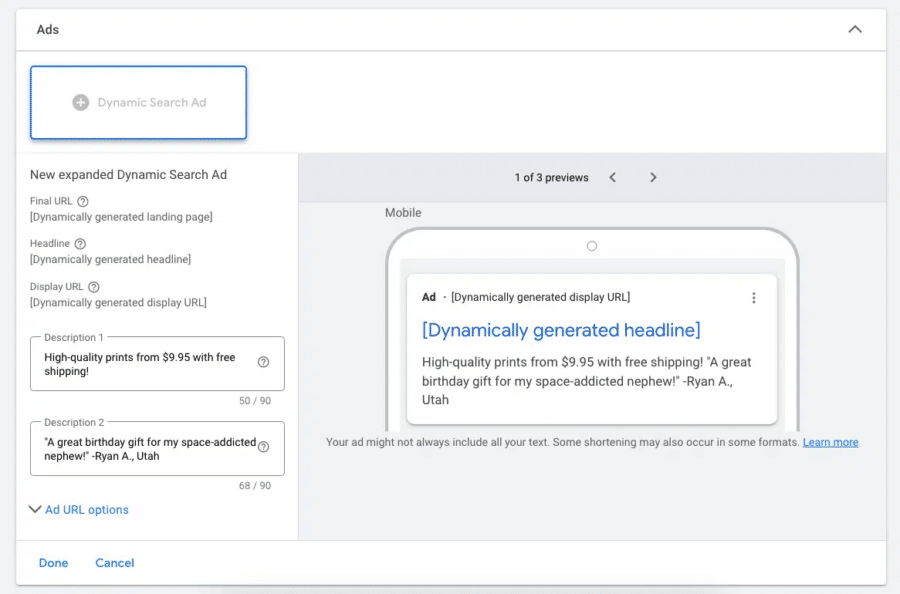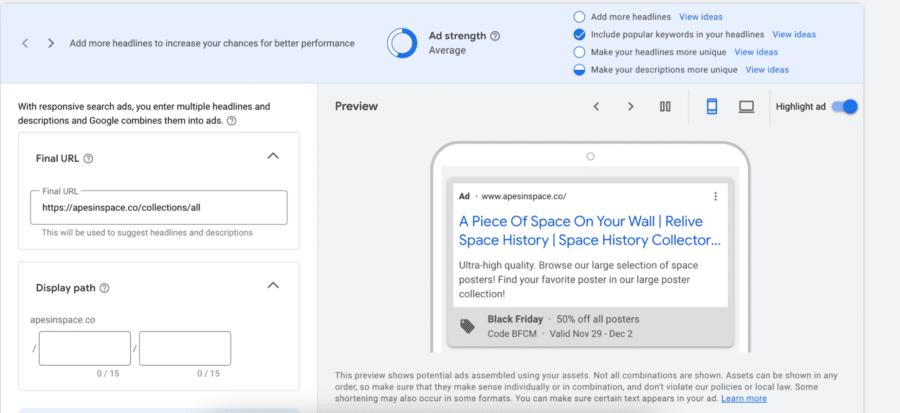Find out the difference between these two Search Ads features and learn which one is right for your business.
Many advertisers confuse Dynamic Search Ads and Responsive Search Ads.
I don’t blame them. Google picked very similar names for concepts that aren’t really the same.
In this article, we’ll look at how Dynamic Search Ads are different from Responsive Search Ads, and figure out which one is right for your campaigns.
Table of Contents
Responsive Search Ads vs Dynamic Search Ads: Which is Better for Your Business?
Explaining the difference between Dynamic Search Ads and Responsive Search Ads is pretty simple.
One is a campaign type, and the other is simply an ad format.
- Dynamic Search Ads: a specific type of Search Ads campaign
- Responsive Search Ads: the only ad format in regular Search Ads campaigns
So which one is right for your business will depend on what you’re trying to do.
In the next sections, we’ll go over what each one is and when it might be interesting to use in your Google Ads account.
What are Dynamic Search Ads?
Dynamic Search Ads (DSA) is a specific type of Search Ads campaign.

Instead of you coming up with keywords and writing the ad copy, Google uses the pages on your own website to create the ads, and decide which search queries to appear for.
Benefits of Dynamic Search Ads
Here are the most common reasons why many businesses use DSAs:
- DSAs save time. Since dynamic search ads utilize your website content, you don’t need to manually map keywords and ad texts to each of your products.
- Show more relevant headlines. Google Ads can automatically create ads with clear headlines for your most relevant pages using DSAs.
- Drive more traffic. With DSAs, Google Ads can help you cover a wider set of search queries that you haven’t tapped into with your regular Search campaigns. Beginner-friendly. Because DSAs are mostly automated, there is less that can go wrong. That makes it a good starter campaign.
If your business has a good website and you don’t have the time or experience to get into regular Search Ads, Dynamic Search Ads can be a great alternative.
Limitations of Dynamic Search Ads
Although it sounds great, there are also some clear limitations to Dynamic Search Ads:
- Lack of headline customization. The automatic generation of headlines is a double-edged sword. While it can save you time as you don’t need to write your own headlines, that lack of control can also result in headlines that don’t connect the search query to the landing page as well as they could.
- You need to keep your website updated. As DSAs generate ads from your website’s content, you need to maintain your website regularly. This includes ensuring that your landing page is always available and the content is always up-to-date and well-optimized. The quality of your ads will always depend on how optimized your website is.
Now that you have a better understanding of what Dynamic Search Ads are, let’s take a closer look at Responsive Search Ads.
What are Responsive Search Ads?
Responsive Search Ads (RSAs) are the default ad format for regular Search Ads campaigns. They replaced Expanded Text Ads back in 2022.

Instead of being created automatically, these are ads that you have to put together yourself.
You can give Google up to 15 headlines and 4 description text, and then Google will put together relevant combinations and see which ones work best.
The main benefit of Responsive Search Ads is control.
Unlike automatically generated headlines, with RSAs you have full control over what headlines can appear.
And by making smart use of pinning, you can control how your ads appear.
But, if you think that your work is done after you give Google a couple of headlines and descriptions, think again!
Below are a few best practices you can implement. But if you want to get to the full details, check out our article on Responsive Search Ads optimization.
When Should You Use Dynamic Search Ads vs Responsive Search Ads?
The best way to think about this is not as an alternative but as complimentary.
I’ve use both of them regularly and both can drive good results.
When to use Dynamic Search Ads?
Here are some general rules of thumb for when to use DSA.
Use Dynamic Search Ads if:
- You don’t have the expertise to launch a more hands-on campaign and simply need something automated
- You want to launch Search Ads quickly
- You have many landing pages and products that don’t have ads. DSAs will target all your pages and make ads for them, increasing the reach of your overall site
When to Use Responsive Search Ads?
This one is pretty simple, you’ll use Responsive Search Ads every time you create a regular Search Ads campaign.
Dynamic Search Ads vs Responsive Search Ads: Both Can Work
Dynamic Search Ads and Responsive Search Ads shouldn’t be compared against each other.
They are two different concepts.
Dynamic Search Ads are a specific type of campaign. And Responsive Search Ads are an ad format.
You don’t have to choose between them and you can have both in your campaigns.
